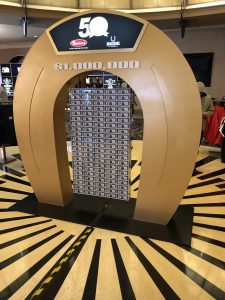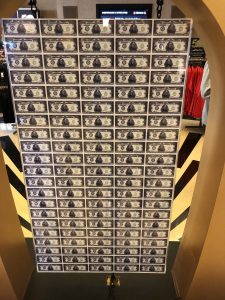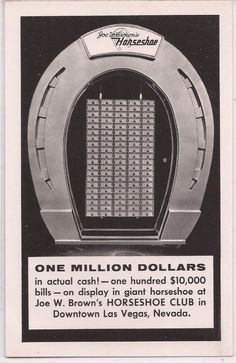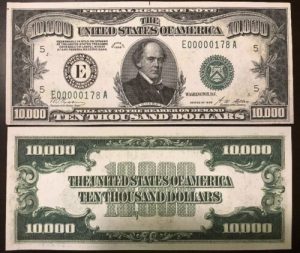
That’s a display of a million dollars in the lobby of the World Series Of Poker at the Rio in Las Vegas, showing five columns of twenty rows of $10,000 bills.

It’s a throwback to a promotional stunt that started at a casino once called Binion’s Horseshoe. But at the time, it wasn’t called Binion’s — it was Joe W. Brown’s Horseshoe Club. According to a blog entry at Caesars.com:
Back in the day (1951), Vegas icon Benny Binion purchased the Apache Hotel and Eldorado Club, in downtown Las Vegas, and re-opened them as the Horseshoe Casino. Stories from the early days of the Horseshoe are the stuff of Vegas legend.
Those were pretty wild times, and in 1953, Benny Binion actually served a few years (1953 to 1957) in Leavenworth Penitentiary for tax evasion. Not wanting his baby, the Horseshoe, to fall into the wrong hands during his stint in the bighouse, Binion sold his share of the Horseshoe to a fellow gambler, Joe W. Brown.
While Brown minded the shop, he installed the famous $1 million dollar display on the Horseshoe’s casino floor. Benny Binion revamped the display in 1964 when he regained full control of his beloved Horseshoe.
Here’s what the original looked like:

Unlike those bills, the ones in the current Rio display are reproductions. There haven’t been any $10,000 bills printed by the US government since 1945, and they were officially discontinued in 1969, although somewhere around three hundred remain in the hands of collectors, and valued at almost $200,000. Here’s what they looked like:

The man in the middle of the bill is Salmon P. Chase, who was Secretary of the Treasury during the Civil War before resigning to become Chief Justice of the US Supreme Court.
My friend and noted poker historian Nolan Dalla, who worked for the Horseshoe and the WSOP, wrote about the display on his blog in 2016. His full piece is worth your time, but here’s an excerpt about what happened to the original bills that were on display…
When the Binion family got into a bitter squabble and ultimately split apart in 1998 (I didn’t start working for Jack Binion until 2000, and later Becky Binion-Behnen in 2002 — by that time the money was long gone from the premises), the million-dollar display became an expendable asset. It was sold and carted off to a coin dealer at an undisclosed price, estimated by some in the know at about four-times its face value, everyone involved in the transaction acutely aware of the banknotes’ unprecedented rarity. When the history of Binion’s Horseshoe does get written, it shall likely be noted that the removal of the famous tourist attraction was the one of several nails in the coffin of gambling’s most legendary institutions…
The once-famous currency collection has been carved up, split apart and is unlikely ever again to see the light of day as a complete unit. Inspired by previous success and a master of promotions, Jack Binion [Benny’s son] later created his own version of the million-dollar display when he first opened up his Horseshoe Casino in Bossier City, Louisiana. The grand entrance along the hallway remains wallpapered with ten-thousand $100 bills, undoubtedly the biggest collection of Ben Franklin portraits ever assembled in one place.
If you had one of those Chase-faced notes in 1969, you could have used it to buy into the first World Series Of Poker, at a time when no one called it the Main Event because the $10,000 showdown was the entire series. Now, the WSOP is made up of dozens of events, taking place over the course of seven weeks, with buy-ins of a few hundred to tens of thousands of dollars.
I won’t be in any of them, because I no longer have the stamina necessary to play for up to 12 hours a day — plus the knowledge that I’m not a good enough poker player to make the time commitment worth my while. I’m happy to sit down in one of the cash games that coincide with the tournaments at the WSOP (and other poker rooms around Vegas) for a few hours, then move on to something else and come back later, on my own schedule.
